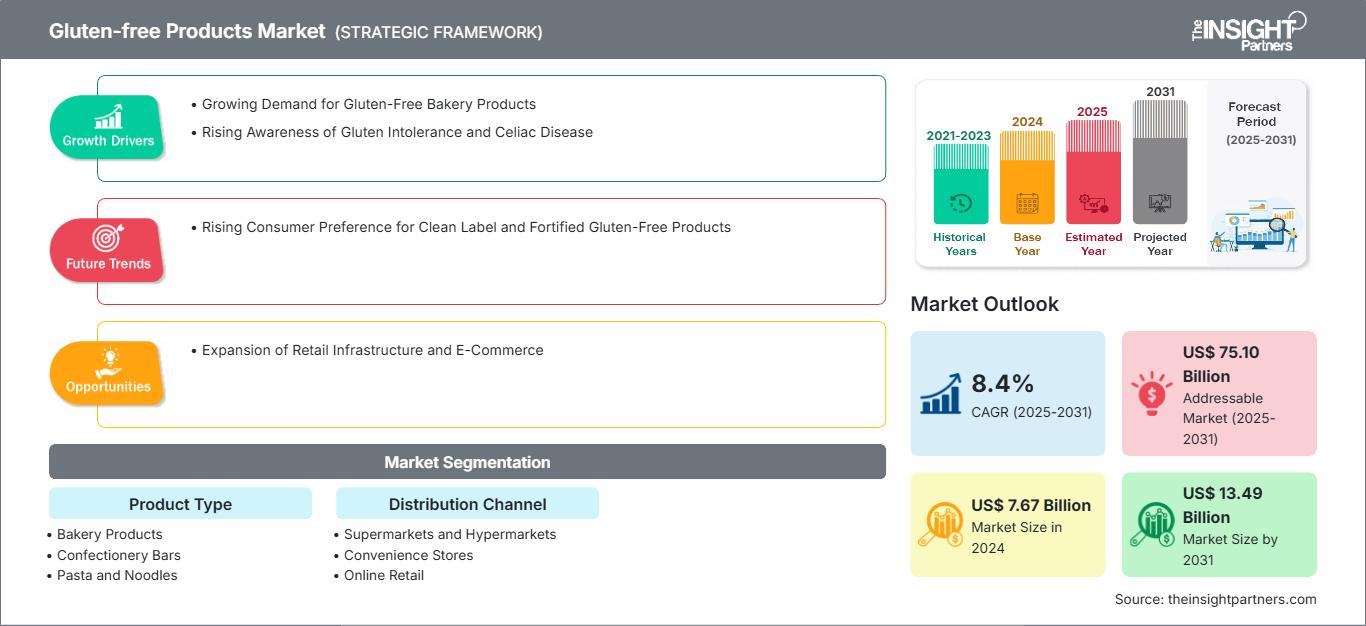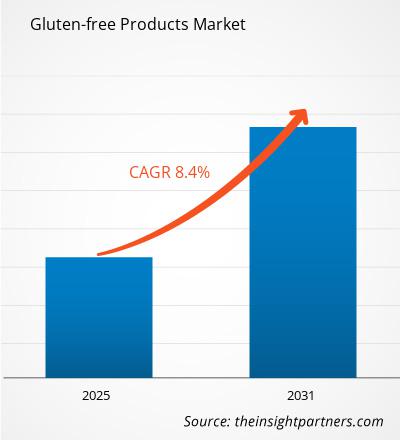Der Markt für glutenfreie Produkte soll von 7,67 Milliarden US-Dollar im Jahr 2024 auf 13,49 Milliarden US-Dollar im Jahr 2031 anwachsen. Von 2025 bis 2031 wird ein durchschnittliches jährliches Wachstum (CAGR) von 8,4 % erwartet. Die steigende Verbraucherpräferenz für Clean-Label- und angereicherte glutenfreie Produkte dürfte im Prognosezeitraum neue Trends auf dem Markt mit sich bringen.
Marktanalyse für glutenfreie Produkte
Das steigende Bewusstsein für Glutenunverträglichkeit und Zöliakie lässt die Nachfrage nach glutenfreien Produkten sprunghaft ansteigen und veranlasst Marktteilnehmer, ihre Geschäftsreichweite durch strategische Initiativen landesweit auszuweiten. Darüber hinaus macht die zunehmende Nutzung von E-Commerce-Plattformen den stationären Einzelhandel unabhängiger. Daher wird erwartet, dass der Ausbau der Einzelhandelsinfrastruktur und des E-Commerce in den kommenden Jahren lukrative Möglichkeiten auf dem globalen Markt für glutenfreie Produkte bieten werden.
Marktübersicht für glutenfreie Produkte
Der globale Markt für glutenfreie Produkte hat in den letzten Jahren ein deutliches Wachstum erlebt, das auf das steigende Bewusstsein der Verbraucher für glutenbedingte Erkrankungen wie Zöliakie und Glutenunverträglichkeit sowie einen allgemeinen Wandel hin zu einem gesünderen Lebensstil zurückzuführen ist. Viele Verbraucher verbinden glutenfreie Ernährung mittlerweile mit einer besseren Verdauung, mehr Energie und besserer Gewichtskontrolle, auch ohne medizinische Notwendigkeit. Infolgedessen haben sich glutenfreie Produkte von Nischenangeboten zu Mainstream-Produkten entwickelt und sind in Supermärkten, Restaurants und Online-Plattformen zunehmend erhältlich. Innovationen in der Produktentwicklung haben zu verbessertem Geschmack und Textur geführt und glutenfreie Alternativen attraktiver gemacht. Zu den wichtigsten Produktkategorien zählen Backwaren, Snacks, Pasta und Fertiggerichte. Das Wachstum ist besonders stark in entwickelten Regionen wie Nordamerika und Europa, während die Schwellenmärkte im asiatisch-pazifischen Raum und in Lateinamerika eine steigende Nachfrage verzeichnen. Die Entwicklung des Marktes spiegelt veränderte Ernährungspräferenzen, ein steigendes Gesundheitsbewusstsein und eine wachsende Nachfrage nach Transparenz und Clean-Label-Zutaten in der Lebensmittelproduktion wider.
Passen Sie diesen Bericht Ihren Anforderungen an
Sie erhalten kostenlos Anpassungen an jedem Bericht, einschließlich Teilen dieses Berichts oder einer Analyse auf Länderebene, eines Excel-Datenpakets sowie tolle Angebote und Rabatte für Start-ups und Universitäten.
Markt für glutenfreie Produkte: Strategische Einblicke

- Holen Sie sich die wichtigsten Markttrends aus diesem Bericht.Dieses KOSTENLOSE Beispiel umfasst Datenanalysen, die von Markttrends bis hin zu Schätzungen und Prognosen reichen.
Sie erhalten kostenlos Anpassungen an jedem Bericht, einschließlich Teilen dieses Berichts oder einer Analyse auf Länderebene, eines Excel-Datenpakets sowie tolle Angebote und Rabatte für Start-ups und Universitäten.
Markt für glutenfreie Produkte: Strategische Einblicke

- Holen Sie sich die wichtigsten Markttrends aus diesem Bericht.Dieses KOSTENLOSE Beispiel umfasst Datenanalysen, die von Markttrends bis hin zu Schätzungen und Prognosen reichen.
Markttreiber und -chancen für glutenfreie Produkte
Steigendes Bewusstsein für Glutenunverträglichkeit und Zöliakie
Herkömmlicherweise wurden Glutenunverträglichkeit, Zöliakie und andere damit verbundene Krankheiten nicht diagnostiziert und nicht allgemein anerkannt. In den letzten Jahren haben jedoch verbesserte medizinische Erkenntnisse und Gesundheitskampagnen dazu beigetragen, glutenbedingte Erkrankungen zu erkennen. Dies hat zu einem veränderten Verbraucherverhalten geführt: Immer mehr Menschen entscheiden sich dafür, Gluten aus ihrer Ernährung zu streichen oder zu reduzieren, ohne eine formelle Diagnose zu erhalten. Laut Beyond Celiac leidet einer von 133 Amerikanern oder etwa 1 % der Bevölkerung an Zöliakie. Laut einer 2019 in der National Library of Medicine veröffentlichten Studie ist Zöliakie in Saudi-Arabien weit verbreitet. In der Normalbevölkerung beträgt die Prävalenz von durch Biopsie nachgewiesener Zöliakie 10,6 % und die Seroprävalenz 15,6 %.
Ausbau der Einzelhandelsinfrastruktur und des E-Commerce
Die Initiative „Vision 2030“ der saudi-arabischen Regierung war ein wichtiger Motor für die Modernisierung und den Ausbau der Einzelhandelsinfrastruktur des Landes. Diese Initiative zielt darauf ab, die Wirtschaft zu diversifizieren und das Wachstum des privaten Sektors, einschließlich des Einzelhandels, zu fördern. Infolgedessen hat Saudi-Arabien rasch moderne Einzelhandelsflächen wie Hypermärkte, Supermärkte, Einkaufszentren und Convenience Stores entwickelt, die die Verfügbarkeit glutenfreier Lebensmittel deutlich verbessert haben. Große Einzelhandelsketten wie Carrefour, Lulu, Panda und Danube haben ihre Präsenz in Städten weltweit ausgeweitet und führen in diesen Geschäften zunehmend glutenfreie Produkte, um der steigenden Nachfrage gerecht zu werden. Der Einfluss sozialer Medien und des digitalen Marktes hat die Expansion des E-Commerce gefördert, da glutenfreie Marken diese Plattformen nutzen, um potenzielle Kunden zu erreichen und ihre Produkte zu bewerben. Die zunehmende Verbreitung von Internet und Smartphones, der schnelle Zugang zu neuen Technologien, die gestiegene Kaufkraft und der Komfort von Online-Shopping-Plattformen gehören zu den wichtigsten Faktoren, die den E-Commerce fördern. Mit der zunehmenden Verbreitung des E-Commerce in verschiedenen Regionen verstärken auch die Hersteller glutenfreier Produkte ihre Online-Präsenz, indem sie ihre Produkte über Walmart, Tesco, Amazon, Lulu Hypermarket, Carrefour und andere bekannte E-Commerce-Plattformen verkaufen.
Segmentierungsanalyse des Marktberichts für glutenfreie Produkte
Schlüsselsegmente, die zur Ableitung der Marktanalyse für glutenfreie Produkte beigetragen haben, sind Produkttyp und Vertriebskanal.
- Nach Produkttyp ist der Markt in Backwaren (Kuchen und Muffins, Kekse und Plätzchen, Pizza, Brot und Brötchen und andere Backwaren), Süßwarenriegel, Pasta und Nudeln, Frühstückszerealien, Snacks, RTE- und RTC-Mahlzeiten, Mehl und andere unterteilt. Das Segment Backwaren hatte 2024 den größten Marktanteil.
- In Bezug auf die Vertriebskanäle ist der Markt in Supermärkte und Hypermärkte, Convenience Stores, Online-Einzelhandel und andere unterteilt. Das Segment Supermärkte und Verbrauchermärkte hatte 2024 den größten Marktanteil.
Marktanteilsanalyse glutenfreier Produkte nach Geografie
Der geografische Umfang des Marktberichts ist in fünf Regionen unterteilt: Nordamerika, Asien-Pazifik, Europa, Naher Osten und Afrika sowie Süd- und Mittelamerika. Es wird erwartet, dass der Markt in Europa im Prognosezeitraum deutlich wachsen wird.
Der Markt für glutenfreie Produkte in Europa wird durch die hohe Prävalenz von Zöliakie und das zunehmende Bewusstsein der Verbraucher für glutenbedingte Erkrankungen angetrieben. Nach Angaben der Association of European Celiac Societies (AOECS) leidet schätzungsweise 1 von 100 Menschen in Europa an Zöliakie, was über 7 Millionen Betroffenen entspricht. Aufgrund der unterschiedlichen Schwere der Symptome, die von leichten Beschwerden bis hin zu schweren gesundheitlichen Komplikationen reichen, werden jedoch nur etwa 25 % der Fälle diagnostiziert. Die einzige wirksame Behandlung von Zöliakie ist eine strikt glutenfreie Diät, was die Nachfrage nach zertifizierten glutenfreien Lebensmitteln in der gesamten Region angekurbelt hat.
Die Europäische Kommission hat strenge Vorschriften zur Gewährleistung der Sicherheit und Kennzeichnung glutenfreier Produkte erlassen. Die Durchführungsverordnung der Kommission legt Standards für die Angaben „glutenfrei“ (≤20 ppm) und „sehr glutenarm“ (≤100 ppm) fest. Die Europäische Behörde für Lebensmittelsicherheit (EFSA) spielt ebenfalls eine Schlüsselrolle bei der Bewertung gesundheitsbezogener Angaben zu glutenfreien Lebensmitteln und stärkt so das Verbrauchervertrauen. Darüber hinaus hat die AOECS im Jahr 2023 die Gluten-Free Alliance ins Leben gerufen, um die Zusammenarbeit innerhalb der Branche, die Transparenz der Zertifizierung und die Verfügbarkeit glutenfreier Produkte zu verbessern. Diese Initiative steht im Einklang mit dem umfassenderen EU-Rahmen für Lebensmittelsicherheit und fördert standardisierte Test- und Kennzeichnungsverfahren. Der Markt hat sich dank erheblicher Investitionen in Innovationen bei glutenfreien Zutaten und den Ausbau der Produktionskapazitäten durch wichtige Akteure der Branche deutlich weiterentwickelt. Um der steigenden Nachfrage gerecht zu werden, führten mehrere europäische Lebensmittelhersteller neue glutenfreie Backwaren, Nudeln und Snacks ein. So brachte Warburtons, eine führende britische Bäckereimarke, im April 2024 seine „Gluten Free Soft Pittas“ auf den Markt, die in Viererpackungen zu einem empfohlenen Verkaufspreis von 3 Pfund erhältlich sind. Die Pittas sind jetzt bei Sainsbury's und Asda erhältlich. Warburtons hat nach der Einführung der „Cinnamon and Raisin Fruity Buns“ und „Super Soft Seeded Rolls“ erheblich in die Kategorie glutenfrei investiert. Einzelhändler haben zudem die Regalfläche für zertifiziert glutenfreie Artikel vergrößert, unterstützt durch die wachsende Präferenz der Verbraucher für allergenfreie Ernährung über diagnostizierte Fälle von Zöliakie hinaus. Der Ausbau von E-Commerce-Plattformen hat die Verfügbarkeit weiter verbessert, insbesondere in Regionen mit eingeschränkter Verfügbarkeit glutenfreier Optionen im Einzelhandel.
Glutenfreie ProdukteRegionale Einblicke in den Markt für glutenfreie Produkte
Die Analysten von The Insight Partners haben die regionalen Trends und Faktoren, die den Markt für glutenfreie Produkte im Prognosezeitraum beeinflussen, ausführlich erläutert. In diesem Abschnitt werden auch die Marktsegmente und die geografische Lage glutenfreier Produkte in Nordamerika, Europa, im asiatisch-pazifischen Raum, im Nahen Osten und Afrika sowie in Süd- und Mittelamerika erläutert.
Umfang des Marktberichts zu glutenfreien Produkten
| Berichtsattribut | Einzelheiten |
|---|---|
| Marktgröße in 2024 | US$ 7.67 Billion |
| Marktgröße nach 2031 | US$ 13.49 Billion |
| Globale CAGR (2025 - 2031) | 8.4% |
| Historische Daten | 2021-2023 |
| Prognosezeitraum | 2025-2031 |
| Abgedeckte Segmente |
By Produkttyp
|
| Abgedeckte Regionen und Länder | Nordamerika
|
| Marktführer und wichtige Unternehmensprofile |
|
Dichte der Marktteilnehmer für glutenfreie Produkte: Verständnis ihrer Auswirkungen auf die Geschäftsdynamik
Der Markt für glutenfreie Produkte wächst rasant. Die steigende Nachfrage der Endverbraucher ist auf Faktoren wie veränderte Verbraucherpräferenzen, technologische Fortschritte und ein stärkeres Bewusstsein für die Produktvorteile zurückzuführen. Mit der steigenden Nachfrage erweitern Unternehmen ihr Angebot, entwickeln Innovationen, um den Bedürfnissen der Verbraucher gerecht zu werden, und nutzen neue Trends, was das Marktwachstum weiter ankurbelt.

- Holen Sie sich die Markt für glutenfreie Produkte Übersicht der wichtigsten Akteure
Marktnachrichten und aktuelle Entwicklungen zu glutenfreien Produkten
Der Markt für glutenfreie Produkte wird durch die Erhebung qualitativer und quantitativer Daten aus Primär- und Sekundärforschung bewertet, die wichtige Unternehmenspublikationen, Verbandsdaten und Datenbanken umfasst. Einige der wichtigsten Entwicklungen auf dem Markt sind nachfolgend aufgeführt:
- Goodles, ein Hersteller von gesünderer Pasta, hat eine glutenfreie Pastalinie auf den Markt gebracht. Das Sortiment umfasst Formen wie Loopdy-Loos, Lucky Penne und Twistful Thinking. (Quelle: Goodles, Pressemitteilung, Oktober 2024)
- Feel Good Foods, ein Hersteller von glutenfreien Tiefkühlgerichten und Snacks, hat glutenfreie gefrorene Hühnersuppenknödel auf den Markt gebracht. Die Knödel sind mit einer Reismehlmischung umhüllt und mit einer Mischung aus Hühnerfleisch, Brühe, Frühlingszwiebeln und Ingwer gefüllt. (Quelle: Feel Good Foods, Pressemitteilung, Oktober 2024)
Bericht zum Markt für glutenfreie Produkte: Umfang und Ergebnisse
Der Bericht „Marktgröße und Prognose für glutenfreie Produkte (2021–2031)“ bietet eine detaillierte Analyse des Marktes und deckt die folgenden Bereiche ab:
- Marktgröße und Prognose für glutenfreie Produkte auf globaler, regionaler und Länderebene für alle abgedeckten wichtigen Marktsegmente
- Markttrends für glutenfreie Produkte sowie Marktdynamik wie Treiber, Einschränkungen und wichtige Chancen
- Detaillierte Porter's Five Forces- und SWOT-Analyse
- Marktanalyse für glutenfreie Produkte mit wichtigen Markttrends, globalen und regionalen Rahmenbedingungen, wichtigen Akteuren, Vorschriften und aktuellen Marktentwicklungen
- Branchenlandschaft und Wettbewerbsanalyse mit Marktkonzentration, Heatmap-Analyse, prominenten Akteuren und aktuellen Entwicklungen auf dem Markt für glutenfreie Produkte
- Detaillierte Unternehmensprofile
- Historische Analyse (2 Jahre), Basisjahr, Prognose (7 Jahre) mit CAGR
- PEST- und SWOT-Analyse
- Marktgröße Wert/Volumen – Global, Regional, Land
- Branchen- und Wettbewerbslandschaft
- Excel-Datensatz
Aktuelle Berichte
Verwandte Berichte
Erfahrungsberichte
Grund zum Kauf
- Fundierte Entscheidungsfindung
- Marktdynamik verstehen
- Wettbewerbsanalyse
- Kundeneinblicke
- Marktprognosen
- Risikominimierung
- Strategische Planung
- Investitionsbegründung
- Identifizierung neuer Märkte
- Verbesserung von Marketingstrategien
- Steigerung der Betriebseffizienz
- Anpassung an regulatorische Trends




















 Kostenlose Probe anfordern für - Markt für glutenfreie Produkte
Kostenlose Probe anfordern für - Markt für glutenfreie Produkte